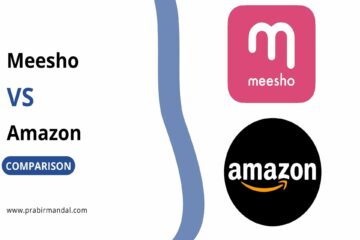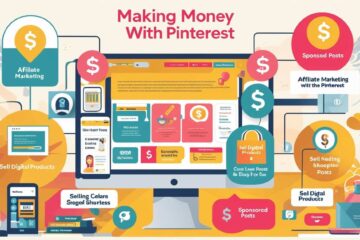If you want to earn passive income online, combining Pinterest with Amazon’s Affiliate Program is a smart and powerful strategy.
With the right approach, you can turn your Pinterest account into a traffic machine that drives clicks and conversions for Amazon products — and puts commissions in your pocket.
In this guide, you’ll learn how to monetize with Amazon Affiliates on Pinterest step-by-step, even if you’re a beginner. From setting up accounts to creating click-worthy pins, every detail is covered to help you start earning faster.
Why Use Pinterest for Amazon Affiliate Marketing?
Pinterest is more than just a platform for inspiration boards. It acts like a visual search engine, with millions of users actively looking for ideas, products, and solutions. That means you can use it to reach a highly engaged audience who’s ready to click and shop.
Here’s why Pinterest works well with Amazon:
- High buyer intent: Users often search with the goal of finding and buying products.
- Long pin lifespan: Unlike Instagram or Twitter, pins can drive traffic for months or even years.
- Free organic traffic: You don’t need to spend on ads to reach people.
Step 1: Join the Amazon Affiliate Program
To start earning commissions, you first need to become an Amazon Associate.
Here’s what you need to do:
- Visit affiliate-program.amazon.com and sign up.
- Add your Pinterest profile or blog as the “website” during the sign-up process.
- Wait for Amazon’s approval.
- Once approved, you can start generating unique affiliate links for any product.
Tip: Amazon requires you to make at least three sales within 180 days to keep your account active.
Step 2: Set Up or Optimize Your Pinterest Account
If you don’t already have a Pinterest business account, now’s the time to create one. It’s free and gives you access to analytics and other tools that a personal account doesn’t offer.
How to set up for success:
- Switch to a Business Account (or create a new one)
- Claim your website or blog (optional but recommended)
- Add a profile picture, keyword-rich bio, and your niche focus
- Enable rich pins for more context (if you have a blog)
Niche Focus Examples: Home décor, beauty, fitness, tech gadgets, parenting, or kitchen tools
Step 3: Research High-Converting Products
Not every product will work well on Pinterest. Focus on items that are visually appealing and relevant to Pinterest users.
What works well:
- Home and kitchen items
- DIY tools and crafts
- Beauty and fashion products
- Fitness and wellness gear
- Tech gadgets and gifts
You can find high-performing products by browsing Amazon Best Sellers or analyzing trending pins in your niche.
Step 4: Create Click-Worthy Pins with Affiliate Links
Once you have a product and its affiliate link, you’ll need to create a pin that grabs attention and drives clicks.
How to design your pin:
- Use tools like Canva or Adobe Express
- Make vertical pins (1000×1500 px is ideal)
- Add clear, bold text overlays (e.g., “Top 5 Must-Have Kitchen Tools”)
- Use high-quality images — either from Amazon or royalty-free sources
Important: You cannot use Amazon product images directly unless you’re using tools like SiteStripe.
Step 5: Add Your Amazon Affiliate Link to the Pin
Pinterest allows direct affiliate links, but you must disclose your relationship.
Here’s how:
- Go to Pinterest and click “Create Pin”
- Upload your image and add a compelling title and description
- Paste your Amazon affiliate link in the “Destination link” field
- In your pin description, write something like:
“This post contains affiliate links. I may earn a small commission at no extra cost to you.”
Optional: Instead of using direct links, you can write a short blog post and link your pin to that post — where the affiliate links are embedded.
Step 6: Optimize Your Pins for Search
Pinterest SEO is the secret weapon to getting discovered by more users.
How to optimize:
- Use relevant keywords in your pin title and description
- Add hashtags related to your niche
- Include keywords in board titles and descriptions as well
For example, if your pin is about “Home Office Essentials,” use terms like:
- #homeoffice
- #workfromhome
- #desksetupideas
- #amazonfinds
Step 7: Stay Consistent and Analyze Performance
Pinterest rewards consistency. Make it a habit to pin regularly — both your own content and curated pins from others.
Use Pinterest Analytics to track:
- Which pins get the most clicks
- What products convert well
- What boards bring in traffic
Based on this data, double down on what works and tweak what doesn’t.
Important Rules to Follow (to Stay Compliant)
- Always disclose affiliate links properly
- Don’t shorten links using cloakers like Bitly (Amazon may ban this)
- Respect Amazon’s TOS, including not using their reviews or prices outside the official API
- Check whether Pinterest’s current policy allows direct affiliate linking in your region (it usually does, but may vary)
Final Thoughts
Using Pinterest to monetize through Amazon Affiliates is one of the most beginner-friendly ways to make money online. You don’t need a blog, a huge following, or a big budget, just the right mix of strategy, visuals, and consistency.
If you follow this step-by-step process, you can create a reliable income stream by simply helping others discover useful products.
So pick a niche, start pinning, and turn your Pinterest hustle into profit.



